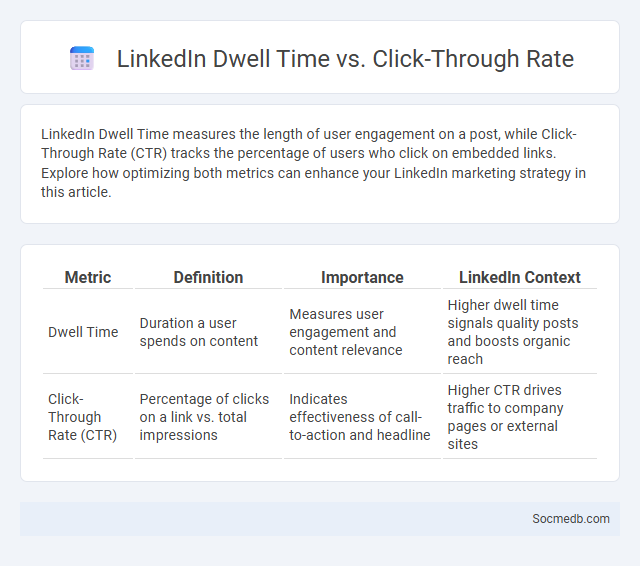
Photo illustration: LinkedIn Dwell Time vs Click-Through Rate
LinkedIn Dwell Time measures the length of user engagement on a post, while Click-Through Rate (CTR) tracks the percentage of users who click on embedded links. Explore how optimizing both metrics can enhance your LinkedIn marketing strategy in this article.
Table of Comparison
| Metric | Definition | Importance | LinkedIn Context |
|---|---|---|---|
| Dwell Time | Duration a user spends on content | Measures user engagement and content relevance | Higher dwell time signals quality posts and boosts organic reach |
| Click-Through Rate (CTR) | Percentage of clicks on a link vs. total impressions | Indicates effectiveness of call-to-action and headline | Higher CTR drives traffic to company pages or external sites |
Understanding LinkedIn Dwell Time
LinkedIn dwell time, the metric measuring how long users engage with content on the platform, significantly impacts your post visibility and reach. Higher dwell time signals to LinkedIn's algorithm that your content is valuable, increasing the chances of it appearing in more feeds and attracting professional connections. Optimizing content for relevance and engagement encourages viewers to spend more time interacting, boosting your overall social media effectiveness.
What is Click-Through Rate (CTR) on LinkedIn?
Click-Through Rate (CTR) on LinkedIn measures the percentage of users who click on a specific link or ad after viewing it in their feed. It is calculated by dividing the total number of clicks by the total impressions and multiplying by 100. A higher CTR indicates greater engagement and relevance of content in LinkedIn marketing campaigns.
LinkedIn Feed Ranking: How Content is Prioritized
LinkedIn's feed ranking algorithm prioritizes content based on user engagement, relevance, and the strength of your network connections to maximize visibility. Posts with high interaction rates such as likes, comments, and shares are more likely to appear at the top of your feed, increasing content reach. Understanding these factors can help you tailor your posts to boost engagement and enhance Your professional presence on the platform.
Dwell Time vs CTR: Key Differences
Dwell time measures the duration users spend engaging with content before returning to the search results, indicating content relevance and quality, while CTR (Click-Through Rate) tracks the percentage of users who click on a link from impressions, reflecting initial interest and effectiveness of a call-to-action. High dwell time often signals valuable, engaging content that satisfies user intent, whereas high CTR shows successful attraction but doesn't guarantee prolonged engagement. Optimizing social media strategies requires balancing both metrics to improve visibility, user retention, and conversion rates on platforms like Facebook, Instagram, and Twitter.
The Role of Dwell Time in Feed Visibility
Dwell time significantly impacts social media feed visibility by signaling user engagement to algorithms. Platforms prioritize content with longer dwell times, increasing the likelihood that Your posts will reach a wider audience. Optimizing content to capture attention and encourage users to spend more time on it enhances visibility and interaction.
How CTR Impacts LinkedIn Content Performance
CTR significantly impacts LinkedIn content performance by directly influencing your post's visibility and engagement metrics. Higher click-through rates signal relevance to LinkedIn's algorithm, increasing the likelihood your content appears in more feeds and reaches a targeted professional audience. Optimizing headlines, visuals, and calls to action drives more clicks, enhancing your content's reach and effectiveness on the platform.
LinkedIn’s Feed Algorithm: Balancing Dwell Time and CTR
LinkedIn's Feed Algorithm prioritizes content that maximizes both dwell time and click-through rate (CTR) to enhance user engagement and platform relevance. By analyzing user interactions such as likes, comments, and shares, the algorithm identifies posts that encourage meaningful conversations and prolonged viewing. This balance helps LinkedIn deliver personalized professional content, improving network quality and increasing advertiser ROI.
Strategies to Improve Dwell Time on LinkedIn
Optimizing your LinkedIn content with engaging storytelling and visually appealing media significantly boosts dwell time by capturing your audience's attention. LinkedIn-specific strategies such as posting thought leadership articles, using interactive polls, and responding promptly to comments encourage users to spend more time exploring your profile. You can further enhance engagement by leveraging LinkedIn analytics to tailor content that resonates deeply with your target network.
Increasing CTR for Enhanced LinkedIn Engagement
Optimizing LinkedIn content with targeted keywords and compelling headlines significantly increases click-through rates (CTR), driving higher user engagement. Utilizing rich media such as videos, infographics, and carousel posts captures audience attention and encourages interaction, thus boosting CTR. Consistent A/B testing of post formats, timing, and call-to-action phrases refines strategies for maximizing LinkedIn visibility and user response rates.
Best Practices for Optimizing Content for LinkedIn Feed Ranking
To optimize your content for LinkedIn feed ranking, focus on creating high-quality, relevant posts that encourage genuine engagement such as comments and shares from your network. Use LinkedIn's native features like polls, articles, and rich media to increase visibility and interaction within your professional community. Ensure your content includes targeted keywords and hashtags relevant to your industry to boost discoverability and connect with your audience effectively.
 socmedb.com
socmedb.com